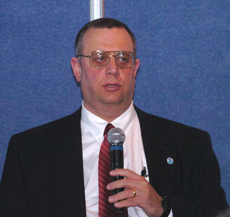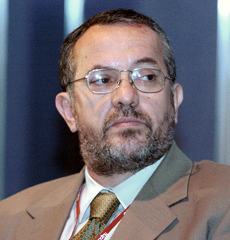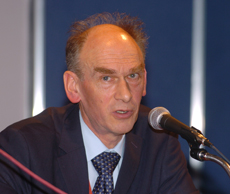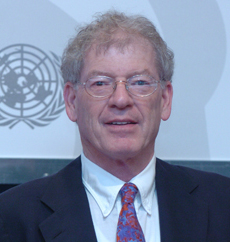|
Events convened on
Monday, 6 December 2004
|
|
Country experiences in implementing
national capacity self assessments
Presented by the Secretariat of the
UNFCCC
|
|
|
|
 |
|
Diana Harutyunyan, UNDP-Armenia,
highlighted broad stakeholder
participation in the NCSA process, and
evaluation of process outputs through
targeted surveys and participatory
discussions. |
|
Diana
Harutyunyan, United Nations
Development Programme (UNDP)-Armenia,
outlined benchmarks along the path
to completing her country’s National
Capacity Self Assessment (NCSA) with
respect to three global conventions,
namely the UNFCCC, the UN Convention
on Biological Diversity, and the UN
Convention to Combat
Desertification. She stressed the
importance of strong national
ownership, as well as the
involvement of high-level decision
makers and convention focal points
in the process. She said the process
had identified capacity gaps
relating to: the incorporation of
adaptation to climate change in the
strategies of key sectors; the
inclusion of greenhouse gas (GHG)
emissions data in the emissions
inventory; a lack of awareness in
the administration; and low levels
of monitoring and evaluation. She
said the cross-cutting assessment
revealed the need for increased
cooperation between central,
regional, and local governing
bodies, and identified the need to
promote environmental education,
technology transfer, and scientific
cooperation.
Heidi
Hallik, Estonia’s Ministry of the
Environment, highlighted
institutional capacity gaps
identified during the NCSA process,
including weak systems for
implementing obligations, poor
cooperation between local and
national governments, and
shortcomings in inter-ministerial
cooperation. Relating
expertise, and a
weak capacity for
undertaking applied
research.
Teofilus Nghitila, Namibia’s Ministry of
Environment and Tourism, said the NCSA
process had demonstrated the need to
develop an integrated approach to
capacity building for implementation of
the three conventions. He highlighted
the need for technical, institutional
and organizational capacity building,
and for support for implementation of
activities at the local level. He
highlighted the prevalence of HIV/AIDS
in his country, and stressed the need to
stabilize this problem and engage in
succession planning to replace lost
capacity.
|
|
|
Bubu Pateh Jallow, Gambia’s Department
of Water Resources, emphasized that
stakeholders were consulted at all
levels of the NCSA process, and
indicated that Gambia’s Climate
Committee had conducted a national
validation workshop to review and
confirm findings. With regards to
capacity gaps identified by the process,
he highlighted: limited expertise; weak
institutional frameworks; and a paucity
of scientific information. He stressed
the need to develop and strengthen
institutional and human capacity,
enhance negotiation skills, develop a
national action plan and implementation
strategy, and improve access to data.
Joyceline Goco, Department of
Environment and Natural Resources of the
Philippines, highlighted national
policies and local initiatives related
to climate change and a public campaign
to raise awareness about climate change.
On the development of a GHG emissions
inventory, she identified capacity gaps
relating to local emission factors and
data collection, analysis and archiving.
She said the NCSA had identified
cross-cutting capacity gaps relating to:
coordination among agencies; information
sharing; and data management. She
highlighted greater collaboration among
stakeholders and heightened awareness as
key outcomes of the NCSA process.
Luis Santos, Uruguay’s Ministry of
Housing, Territorial Regulation and
Environment, indicated that his country
had completed its NCSA in November 2004.
He noted a number of complementary
activities that increase contact with
local groups and institutions,
including: training programmes, and
research and management assistance. He
highlighted several capacity gaps,
including: coordination difficulties
within and among institutions;
insufficient awareness among decision
makers; a dependence on foreign
financial resources; and low public
awareness.
Bo Lim, UNDP, introduced the Global NCSA
Support Programme, noting that the
programme is jointly implemented by the
United Nations Environment Programme and
UNDP. She said the programme will
support partnerships with regional
centers and aims to provide a learning
mechanism for sharing experiences,
capture intellectual capital, and build
capacity.
Discussion: Participants highlighted the
importance of the participation of
economic ministries in the NCSA process,
ensuring financial support for the
implementation of action plans. They
also discussed how national assessments
can feed into regional assessment for
capacity-building needs, and considered
what steps should be taken to address
the priorities identified by the NCSA.
|
|
Pacific Island Global Climate Observing
System: description and progress
Presented by the South Pacific Regional
Environment Programme
|
|
|
 |
|
Howard Diamond, NOAA, identified key
ingredients for success in implementing
observation systems, including broad
participation in observation systems and
establishing regional steering groups. |
|
Alan Thomas, Global
Climate Observation
System (GCOS),
introduced the
principles and goals
of GCOS,
highlighting the
development of a
coordinated
multi-governmental
approach to
providing stable
long-term funding
for observation
systems.
Mark Morrissey,
Pacific Island GCOS
(PI-GCOS),
overviewed the goals
of PI-GCOS, its
history and current
activities. He said
PI-GCOS’s governance
strategy focuses on
regional capacity
building for
observation,
communication, and
socioeconomic
development.
Arona Ngari,
Cook Islands
MetService,
presented a case
study on the Cook
Islands’ activities,
including climate
observations,
capacity building,
and the use of PI-GCOS
activities for
forecasting.
Russell Howorth,
South Pacific
Applied Geoscience
Commission (SOPAC),
gave an overview of
SOPAC’s involvement
in regional
institutions and
activities related
to resource
management,
research, education
and capacity
building. He
presented case
studies on the black
pearl industry
in Manihiki and water
management in Samoa, and
lamented the shortage of
cost-benefit analyses. Jai
Gawander, Fiji Sugar
Corporation, described
economic analyses of the
negative impacts of climate
change on sugar cane
production in Fiji. Noting
that island States’
economies depend on
subsistence agriculture and
tourism, he highlighted the
severe impacts of drought on
all socioeconomic sectors.
Howard Diamond, U.S.
National Oceanic and
Atmospheric
Administration (NOAA),
outlined the implementation
of PI-GCOS, and identified
key ingredients for success,
including: fundraising;
broad participation in
partnerships; full-time
regional program officers;
consolidated planning
mechanisms; and regional
steering groups.
Andrew Matthews, National
Institute of Water and
Atmospheric Research,
stressed the importance of
national-level sector
coordination for resource
management. |
|
|
Opportunities for sustainable climate
change projects and the biomass energy
market
Presented by the Ministry of Ecology,
Province of Misiones, Argentina
|
|
 |
|
Luis Jacobo, Minister of Ecology of the
Province of Misiones, Argentina,
emphasized the commitment and potential
of his region regarding climate change
mitigation and sustainable development. |
|
Luis
Jacobo, Minister of Ecology of the
Province of Misiones, emphasized the
potential of his region for Clean
Development Mechanism (CDM)
projects. He explained that the
Province has both the institutional
capacity and political commitment to
implement CDM projects, and noted
that the Province of Misiones
aspires to becoming a model region
in sustainable development and
climate change mitigation.
Juan Gauto, Province of Misiones,
presented opportunities for CDM
projects in his province, noting
that the region has identified
potential projects in the fields of
energy and land use, including:
small-scale hydro projects with low
environmental impact; biomass
projects benefiting from the forest
biomass available in the region;
capture and utilization of methane
from landfills; building of wooden
houses; and sink projects.
Brian Dawson, UNDP, provided an
overview of UNDP’s activities
related to climate change. He
underscored the fundamental link
between adaptation and mitigation,
and indicated that UNDP will focus
on building capacity to mainstream
climate change into policy making
related to economic development. He
emphasized that mitigation
activities can benefit economic
activity and contribute to
sustainable socioeconomic
development. He also noted
that the CDM is a complex mechanism, and that
it is likely to take a few years
before its full potential can be
realized.
Fernando Cubillos, Carbon Finance Unit
of the World Bank, reviewed the status
of the carbon market resulting from the
upcoming entry into force of the Kyoto
Protocol. He indicated that demand for
credits from CDM projects is likely to
exceed supply, and emphasized that
developing CDM projects is a lengthy
process. He introduced the carbon funds
administrated by the World Bank, and
explained the benefits and requirements
for project owners wishing to sell
carbon credits to these funds. |
|
Implementation Plan for the Global
Observing System for Climate in Support
of the UNFCCC
Presented by the World Meteorological
Organization (WMO)
|
|
 |
|
Paul Mason, GCOS, presented the
Implementation Plan for the Global
Observing System for Climate in Support
of the UNFCCC. |
|
Paul
Mason, GCOS, presented the
Implementation Plan for the Global
Observing System for Climate in
Support of the UNFCCC. He noted that
the Implementation Plan responds to
the Second Report on the Adequacy of
Global Observing Systems for Climate
in Support of the UNFCCC. Mason
underscored the contribution of the
plan to understanding and mitigating
climate change, and said it can also
benefit adaptation. He noted that
the plan has a wide scope, including
43 essential variables from
atmospheric, oceanic and terrestrial
domains and their associated
products. Mason stressed that the
Parties to the UNFCCC both
collectively and individually are
the key actors in the Plan’s
implementation.
Carolina Vera, University of Buenos
Aires, presented the Regional GCOS
Action Plan for South America. She
indicated that the objective of the
Plan is to meet GCOS needs for
observation data for South America,
and
explained that the Plan reviews the
current status of South American
systematic observation programmes,
identifies 11 Action Plan projects,
and contains recommendations and
action plans, as well as anticipated
impacts and benefits. She emphasized
that the implementation of South
America’s Regional GCOS Action Plan
requires long-term commitment from
South American nations, as well as
technical and financial assistance
from external donors.
Miguel Angel Rabiolo, Servicio
Meteorológico Nacional Argentina/WMO,
described the status and functions of
the GCOS observation systems in
Argentina.
|
|
Keep Kyoto on track
Presented by the World Meteorological
Organization (WMO)
|
|
 |
|
Lloyd Wright, GTZ, described a range of
complementary measures implemented in
Bogotá to encourage a shift to public
and non-motorized transport, including:
a bus rapid transit project; street
closures; restraints on car use; and
creation of cycle lanes. |
|
Noting
that transport emissions represent a
major and steadily growing source of
GHG emissions in industrialized
countries, Harald Diaz-Bone, UNFCCC,
indicated that the main growth in
transport emissions results from
increased transport activity. He
explained how a shift toward
high-tech industries and the
implementation of an integrated
environmental policy led to the
successful decoupling of economic
growth from increasing carbon
dioxide emissions in Finland.
Lloyd Wright, Gesellschaft für
Technische Zusammenarbeit (GTZ),
said that, to date, the transport
sector has not played a major role
in mitigation under the UNFCCC
mechanisms. Noting that measures
relating to fuel switching are
generally not cost competitive in
the short term, he highlighted
low-cost projects that increase the
share of public transport and
non-motorized transport. He
emphasized the success of Bogotá’s
bus rapid transit project,
Transmilenio, in facilitating a
switch from private to public
transport.
Mads
Bergendorff, UIC, indicated that rail
transport has a lower average external
cost than its competitors for passengers
and freight. He stressed the need to
facilitate the modal shift toward rail
through the creation of a level-playing
field, where prices reflect the real
cost of each transport mode.
He called for substantial investment in
rail infrastructure and political
leadership to catalyze a modal shift
toward rail. Robin Carruthers, World Bank, described
four projects funded by the Global
Environment Fund and aimed at reducing
transport emissions. He indicated that
these projects seek to maintain the
modal share of public transport, and
noted that the success of
transport-related projects, such as
Transmilenio in Bogotá, is challenging
the perception that transport projects
necessarily entail high investment.
Fernando Petersen, Estudio Ariza y
Asociados, explained that reducing
emissions is not an immediate priority
for people who lack access to basic
needs in Argentina.
Susana Martins, Union of European
Railway Industries, stressed the
commitment of European railway
industries to sustainable transport,
stating that the railway should be the
backbone of public transport. |
|
Hotspots analysis for climate change
impact warning
Presented by the Food and Agriculture
Organization of the United Nations (FAO)
|
|
 |
|
Michael Glantz, National Center for
Atmospheric Research, said auditing is
important for identifying potential
problem areas before they become
hotspots. |
|
Michael Glantz, National Center for
Atmospheric Research, spoke on
environment and climate-related
hotspots. He defined hotspots as a
location or activity where human
interaction with the environment is
considered adverse to the
sustainability of an ecosystem or
human activities relying on it. He
said that auditing allows for the
identification of problem areas
before they become hotspots.
Igor Zonn, Caspian Sea Bulletin,
outlined economic, social and
environmental problems in the
Caspian Sea basin. Noting that more
than 125 000 square kilometers of
the Caspian Sea’s coastline are
severely damaged, he underscored two
new transboundary problems for the
region, namely invasive species and
increased pollution caused by
off-shore gas and oil extraction.
René Gommes, FAO, presented a
hotspot analysis of climate and
HIV/AIDS. He said HIV/AIDS spreads
more rapidly with high population
density, poor living conditions, and
in areas with a high migration rate,
all of which can be exacerbated by
climate change.
Discussion: Participants enquired about
the contribution of climate change to
the spreading of HIV/AIDS compared to
other social and economic factors.
Gommes stressed that HIV/AIDS is part of
a complex of interconnected variables
resulting from limited access to natural
resources, and noted that many of these
variables strongly depend on climate. |
|
|
|







